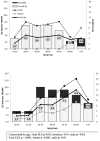Epidemiology of systemic lupus erythematosus and cutaneous lupus erythematosus in a predominantly white population in the United States
- PMID: 25369985
- PMCID: PMC4418944
- DOI: 10.1002/acr.22502
Epidemiology of systemic lupus erythematosus and cutaneous lupus erythematosus in a predominantly white population in the United States
Abstract
Objective: Epidemiologic studies comparing the incidence and prevalence of systemic lupus erythematosus (SLE) and isolated cutaneous lupus erythematosus (CLE) are few. Olmsted County, Minnesota provides a unique setting for such a study owing to resources of the Rochester Epidemiology Project. We sought to describe and compare the incidence and prevalence of SLE and CLE from 1993-2005.
Methods: SLE cases were identified from review of medical records and fulfilled the 1982 American College of Rheumatology classification criteria. CLE cases included patients with classic discoid lupus erythematosus, subacute CLE, lupus panniculitis, and bullous lupus erythematosus. Age- and sex-adjusted incidence and prevalence were standardized to the 2000 US white population.
Results: The age- and sex-adjusted incidence of SLE (2.9 per 100,000; 95% confidence interval [95% CI] 2.0-3.7) was similar to that of CLE (4.2 per 100,000; 95% CI 3.1-5.2, P = 0.10). However, the incidence of CLE was 3 times higher than SLE in men (2.4 versus 0.8 per 100,000; P = 0.009). The age- and sex-adjusted prevalence of CLE on January 1, 2006 was higher than that of SLE (70.4 versus 30.5 per 100,000; P < 0.001). The prevalences of CLE and SLE in women were similar, but the prevalence of CLE was higher in men than in women (56.9 versus 1.6 per 100,000; P < 0.001). The incidence of CLE rose steadily with age and peaked at 60-69 years.
Conclusion: The incidences of CLE and SLE are similar, but CLE is more common than SLE in men and in older adults. These findings may reflect differences in genetic or environmental etiology of CLE.
© 2015, American College of Rheumatology.
Figures
References
-
- Gilliam JN, Sontheimer RD. Distinctive cutaneous subsets in the spectrum of lupus erythematosus. J Am Acad Dermatol. 1981;4(4):471–475. - PubMed
-
- Tebbe B, Orfanos CE. Epidemiology and socioeconomic impact of skin disease in lupus erythematosus. Lupus. 1997;6(2):96–104. - PubMed
-
- Petri M. Epidemiology of systemic lupus erythematosus. Best Pract Res Clin Rheumatol. 2002;16(5):847–858. - PubMed
-
- Gronhagen CM, Fored CM, Granath F, Nyberg F. Cutaneous lupus erythematosus and the association with systemic lupus erythematosus: a population-based cohort of 1088 patients in Sweden. Br J Dermatol. 2011;164(6):1335–1341. - PubMed
Publication types
MeSH terms
Grants and funding
LinkOut - more resources
Full Text Sources
Other Literature Sources
Medical



